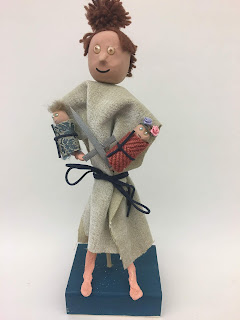Fourth graders at The Rashi School learned about the Chinese zodiac and created drawings of rats to celebrate the Year of the Rat. Then, they cut the drawings out of red paper in the tradition of intricate Chinese paper cuttings.
Wednesday, January 29, 2020
Wednesday, January 8, 2020
Broken/Repaired Pottery
My God, guard my speech from evil
and my lips from telling lies.
Before those who say bad things about me,
Before those who say bad things about me,
I will not respond; I will be humble.
(Elohai Netzor prayer)
Middle school
students at The Rashi School created these pottery
pieces in response to the Jewish Elohai Netzor prayer.
First, we discussed the meaning of the prayer and shared personal responses and
experiences. We spoke about the power
of words; how both negative and positive words can have a significant impact on
those around us. We talked about the
challenge of “guarding our tongue” and not getting caught up in gossip and
talking behind someone’s back. In
response to this discussion, students built vessels using slab construction
techniques. Next, they wrote words on the vessels to express the ways, positive
and negative, in which the spoken or written word can affect themselves and
others. They then dropped the vessels to show the literal and metaphorical
breakage that occurs when words are used for harm.
Finally, they used gold glue to repair their
vessels. This was inspired by Japanese kintsugue pottery, wherein artists use
gold enamel to repair broken pottery. This is done to shows that the value and
beauty of the object transcends the object itself, and there is also value and
beauty in the history of the object.
This also demonstrated that even when harmful words are spoken, it is
our duty to try to repair the relationships that might have been hurt or broken
because of them. The repaired
relationship wouldn’t look the same, but would have elements of both old and
new.
We prompted the students to think deeply and to
make personal connections about the following question as they repaired their
vessels:
· What does the “gold” that we are using for repair represent in real
life? How, and how much can we “fix” ourselves and others when our words do
damage?
· To what extent can your vessel, and your spirit, ever be the same
when there is breakage and repair?
My God, guard my speech from evil
and my lips from telling lies.
Before those who say bad things about me,
Before those who say bad things about me,
I will not respond; I will be humble.
Open my heart to Your Torah, that I may do good in the world through mitzvot.
As for all who think bad of me—help to change their minds and their ways.
Act for Your own sake, for the sake of Your Power,
for the sake of Your Holiness, for the sake of Your Torah,
so that we, Your loved ones may be helped.
Save us with Your power, and answer me.
Elohai,
n’tzor l’shoni meira us’fatai
midabeir mirmah, v’limkal’lai nafshi
tidom, v’nafshi ke-afar lakol tih’yeh.
P’tach libi b’Toratecha, uv’mitzvotecha
tirdof nafshi. V’chol hachoshvim
alai raah, m’heirah hafeir atzatam
v’kalkeil machashavtam. Aseih l’maan
sh’mecha, aseih l’maan y’minecha, aseih
l’maan k’dushatecha, aseih l’maan
Toratecha. L’maan yeichaltzun y’didecha,
hoshiah y’mincha vaaneini.
midabeir mirmah, v’limkal’lai nafshi
tidom, v’nafshi ke-afar lakol tih’yeh.
P’tach libi b’Toratecha, uv’mitzvotecha
tirdof nafshi. V’chol hachoshvim
alai raah, m’heirah hafeir atzatam
v’kalkeil machashavtam. Aseih l’maan
sh’mecha, aseih l’maan y’minecha, aseih
l’maan k’dushatecha, aseih l’maan
Toratecha. L’maan yeichaltzun y’didecha,
hoshiah y’mincha vaaneini.
Tuesday, January 7, 2020
Fifth Grade Maccabee Sculptures
Fifth graders worked on these Maccabee sculptures for the whole semester. The unit began with an overview of the history of figure drawing. As artists learned more about the proportions of the human body, the human form in art began to look more realistic.
Lascaux caves, France 10,000 years ago
Ancient Egypt
Michelangelo, 1500
We then moved to practicing figure drawing. Students used wooden manikins as models, and observed characteristics such as leg length, width of torso, and shapes of feet facing forward.
To begin the process of designing their Maccabee, we discussed and researched the history of Chanukah and the style of the Maccabees by consulting illustrated storybooks. Next, they sketched their Maccabee. To build it in three dimensional form, they began by sculpting with aluminum armature wire, which then covered in plaster wrap. They sculptured the heads out of model magic clay, inserting beads for eyes and gluing on yarn for hair. They also added clothes and belts made of fabric and ribbon. Finally, they used wood, tin foil, and other materials to create accessories for their Maccabees.
Subscribe to:
Comments (Atom)
































